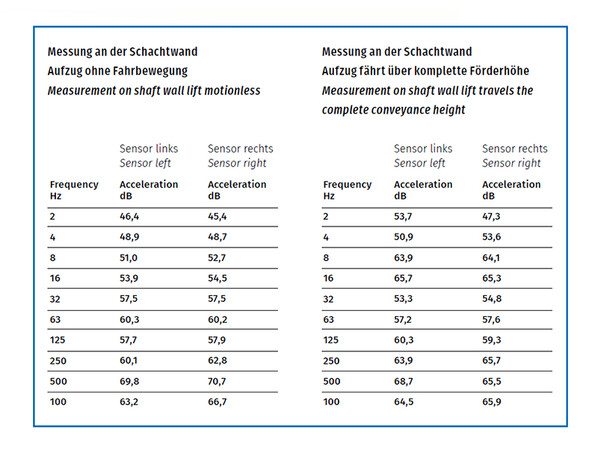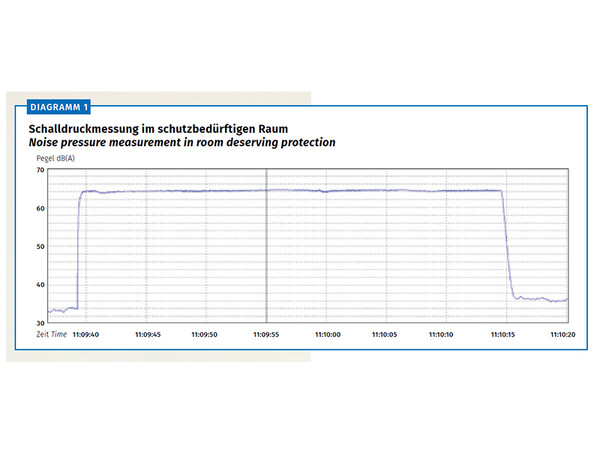Noise insulation in lift construction: Structure-borne noise emissions
In the second article in the new series on the subject of noise insulation, the subject is structure-borne noise emission and its decisive effects. This article will give you an overview while many details will receive more attention in subsequent editions of the LIFTjournal.
By Ulrich Nees and Jan König
In lifts without machine rooms, structure-borne noise emissions are the main reason for the failure to achieve the noise insulation targets in neighbouring rooms or those deserving protection.
The following points are decisive for noise transmission:
– Surface-related mass of the wall between lift shaft and room deserving protection
– Pressure-resistance class of the concrete according to DIN EN 206 / DIN 1045-2 / DIN EN 13791
– Structure-borne noise bridges in the wall and/or between two walls
– Superposition of flanking components (landings, stairs, ceilings, etc.)
– Defective effect of oscillation insulation
– Oscillation speed of drive/machine
– Relationship between rotating and static mass of the drive/machine
– Moment of resistance of supporting structures (motor mount, rail brackets, guide rails)
– Smooth running of traction sheave and deflection pulleys
– Lifting gear tension in lifting gear set
– Travel quality and performance data of lifts
 Table 1: Lift motionless in lift shaft. Table 2: Lift moving through the lift shaft. Table 2 lists the structure-borne noise level measured during trips of the car through the lift shaft according to DIN 8989. Photo: © Ing4Lifts
Table 1: Lift motionless in lift shaft. Table 2: Lift moving through the lift shaft. Table 2 lists the structure-borne noise level measured during trips of the car through the lift shaft according to DIN 8989. Photo: © Ing4LiftsApart from the surface-related mass (1), the pressure-resistance class of the concrete is an important factor. If the lift shaft wall has a low pressure-resistance class, the structure-borne noise level, even when the lift is not even moving, is comparable with the structure-borne noise levels produced by the lift when it is moving at nominal speed.
Comparison between tables 1 and 2 between shut-down and travelling lifts shows that the structure-borne noise level is in part lower in travelling lifts (vibration, frequency superposition) than in motionless / shut-down lifts.
If the pressure resistance class of the concrete is too low, the forces acting cannot be absorbed by the anchor rails or dowel attachments. If the guide rails cannot be properly fixed and they have too much play, generation of air- or structure-borne noise is unavoidable.
Lift shaft walls can be compared
 Noise pressure measurement in room deserving protection. This problem will be examined in detail in the next article. Photo: © Ing4Lifts
Noise pressure measurement in room deserving protection. This problem will be examined in detail in the next article. Photo: © Ing4LiftsIf you want to examine structure-borne noise transmission from the lift shaft to rooms deserving protection, tests can be carried out with a small hammer mechanism and/or with the impact-echo procedure. The surface (concrete wall and/or anchor rail) is made to vibrate by a mechanical impact or a series of blows.
The advantage of this procedure is that the lift shaft walls can be compared with each other without extraneous influences. The airborne noise level in diagram 1 at 65 dB(A) was produced in a room deserving protection next to the lift shaft using a test with a small hammer mechanism.
The cause for the airborne noise level of 65 dB(A) in this measurement was a pressure resistance class that was too low and contact between the reinforcement and anchor rail. Contact between the anchor rail and reinforcement can be demonstrated by radar measurement, among other things (surface scan, line scan and/or A-scan with envelope).
Jan König is the owner of the engineering office (VDI) Ing4Lifts.
Ulrich Nees is the owner of "Aufzug-Systeme + Beratung Ulrich Nees".
(1) see DIN 8989 // Table 4
More information: ing4lifts.de
aufzugsystemeberatung.de
Noise insulation in lift building: A closed book?

























Write a comment